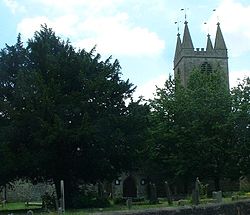Marksbury
| Marksbury | |
| Somerset | |
|---|---|
 St Peter's Church, Marksbury | |
| Location | |
| Location: | 51°21’31"N, 2°28’44"W |
| Data | |
| Population: | 397 (2011[1]) |
| Post town: | Bath |
| Postcode: | BA2 |
| Dialling code: | 01761 |
| Local Government | |
| Council: | Bath & NE Somerset |
| Parliamentary constituency: |
North East Somerset |
Marksbury is a small village and parish in the Keynsham Hundred of Somerset, about four miles from Keynsham itself. It is situated where the A39 road meets the A368, around seven miles from Bath. The civil parish, which includes the villages of Hunstrete and Stanton Prior, has a population of 397.[1]
History
Stantonbury Camp is the site of an Iron Age hillfort near Stanton Prior. It is a Scheduled Ancient Monument. The hillfort, which is at the top of an isolated outcrop of Oolitic Limestone,[2] close to the A39 road is on the route of the Wansdyke.[3]
In 926 Æthelstan gave the manor, then spelled Merkesburie, to his son. It was later gifted to Glastonbury Abbey and in one of the Danelaw wars was taken by Danish troops. It was restored to the abbey again after the victory of Edgar the Peaceful.[4]
Marksbury was listed in the Domesday Book of 1086 as Mercesberia.[5] The name of the village is thought to come from Old English either as ‘Mǣrec’s or Mearc’s stronghold’ (from an Old English male personal name + burh ‘stronghold’, ‘fortified place’, dative byrig), or as ‘stronghold on a boundary’ (from mearc ‘boundary’, possibly a reference to the Wansdyke, + burh, byrig).
The village has a primary school.
Church
The church of St Peter, is an ancient structure, with a tower containing six bells. It is believed to be late 12th-century in origin but mainly from the 15th century. The tower has three stages; the first stage has diagonal buttresses, a canted stair turret in the return of tower and nave and a very small west door with a canted flat arch under a 2-light, chamfered mullion window dated 1634. The second stage has a cusped 2-light window with heavy louvres to the north, a blocked single light to the east and 2-light chamfered, vaguely pointed windows south and west, contemporary with third stage which has one enormous, round headed window with raised architrave and louvres per side, thin, embattled parapet dominated by four pyramidal pinnacles with vanes. The nave has two 2-light windows under hoodmoulds flanking a blocked, moulded round-headed door under a plaque dated 1627. The buttressed, off-centre chancel has to north one window as elsewhere, 3-light east window of 1875. There are several monuments in the chancel including those to Counsell, 1671, and Wadden, 1682. In the nave is a monument to Boulter 1782, by Brewer of Box. Reverend William Counsell was the rector (1662–74). The church is a Grade-II* listed building.[6] An unidentified monument in the churchyard is also listed.[7]
On Wingsbury Hill are remains of an ancient chapel, probably belonging to a monastery, which formerly existed here.
Notable residents
- Joseph Harding, known for being the "Father of Cheddar Cheese"[8]
Other Grade-II-listed buildings
- Historic England. "Church Farmhouse (32696)". Images of England. http://www.imagesofengland.org.uk/Details/Default.aspx?id=32696
- Historic England. "Court Farmhouse (32694)". Images of England. http://www.imagesofengland.org.uk/Details/Default.aspx?id=32694
- Historic England. "Winsbury House (32697)". Images of England. http://www.imagesofengland.org.uk/Details/Default.aspx?id=32697
- Historic England. "No. 123 (32712)". Images of England. http://www.imagesofengland.org.uk/Details/Default.aspx?id=32712
- Historic England. "Crispin Cottage (32702)". Images of England. http://www.imagesofengland.org.uk/Details/Default.aspx?id=32702
- Historic England. "No. 47 (32705)". Images of England. http://www.imagesofengland.org.uk/Details/Default.aspx?id=32705
- Historic England. "May Tree Cottage (32708)". Images of England. http://www.imagesofengland.org.uk/Details/Default.aspx?id=32708
- Historic England. "The Cottage (32709)". Images of England. http://www.imagesofengland.org.uk/Details/Default.aspx?id=32709
- Historic England. "Badger Cottage (32711)". Images of England. http://www.imagesofengland.org.uk/Details/Default.aspx?id=32711
- Historic England. "Barn and attached farm buildings about 30 metres south-east of Poplar Farm (32721)". Images of England. http://www.imagesofengland.org.uk/Details/Default.aspx?id=32721
- Historic England. "Becket's Place (formerly Elm Farmhouse) (32706)". Images of England. http://www.imagesofengland.org.uk/Details/Default.aspx?id=32706
- Historic England. "Church Farmhouse, Stanton Prior (32715)". Images of England. http://www.imagesofengland.org.uk/Details/Default.aspx?id=32715
- Historic England. "Lower Church Farmhouse (32707)". Images of England. http://www.imagesofengland.org.uk/Details/Default.aspx?id=32707
- Historic England. "Outbuildings and barn about 15 metres north of Priory Farmhouse (32718)". Images of England. http://www.imagesofengland.org.uk/Details/Default.aspx?id=32718
- Historic England. "Poplar Farmhouse (32720)". Images of England. http://www.imagesofengland.org.uk/Details/Default.aspx?id=32720
- Historic England. "Pound about 80 metres north-east of Priory Farmhouse (32719)". Images of England. http://www.imagesofengland.org.uk/Details/Default.aspx?id=32719
- Historic England. "Priory Farmhouse (32717)". Images of England. http://www.imagesofengland.org.uk/Details/Default.aspx?id=32717
- Historic England. "The Cottage (32722)". Images of England. http://www.imagesofengland.org.uk/Details/Default.aspx?id=32722
- Historic England. "The Mount (32703)". Images of England. http://www.imagesofengland.org.uk/Details/Default.aspx?id=32703
- Historic England. "The Old Rectory (32716)". Images of England. http://www.imagesofengland.org.uk/Details/Default.aspx?id=32716
- Historic England. "Whidcombe Farmhouse (32710)". Images of England. http://www.imagesofengland.org.uk/Details/Default.aspx?id=32710
References
- ↑ 1.0 1.1 "Marksbury Parish". Neighbourhood Statistics. Office for National Statistics. http://neighbourhood.statistics.gov.uk/dissemination/LeadTableView.do?a=7&b=11126341&c=Marksbury&d=16&e=61&g=6387752&i=1001x1003x1032x1004&m=0&r=1&s=1388523654105&enc=1&dsFamilyId=2491. Retrieved 31 December 2013.
- ↑ "Area 6 Hinton Blewett and Newton St Loe Plateau Lands". Rural Landscapes. Bath and North East Somerset Council. http://www.bathnes.gov.uk/sites/default/files/rural_landscapes_-_chapters_1-6.pdf. Retrieved 3 June 2017.
- ↑ "Stantonbury Hill". Wansdyke Project 21. http://www.wansdyke21.org.uk/wansdyke/wanwesteast/wanwest3.htm.
- ↑ Robinson, W.J. (1915). West Country Churches. Bristol: Bristol Times and Mirror Ltd. pp. 54–60.
- ↑ Robinson, Stephen (1992). Somerset Place Names. Wimborne, Dorset: The Dovecote Press Ltd. ISBN 1-874336-03-2.
- ↑ Historic England. "Church of St Peter (32695)". Images of England. http://www.imagesofengland.org.uk/Details/Default.aspx?id=32695. Retrieved 22 April 2006
- ↑ Historic England. "Unidentified Monument, in the churchyard and 2 metres south of nave of Church of St Lawrence (32714)". Images of England. http://www.imagesofengland.org.uk/Details/Default.aspx?id=32714. Retrieved 22 April 2006
- ↑ Heeley, Ann; Vidal, Mary. Joseph Harding, Cheddar Cheese-Maker. Friends of the Abbey Barn, Glastonbury, 1996
Outside links
| ("Wikimedia Commons" has material about Marksbury) |
